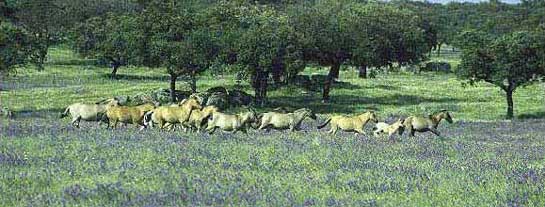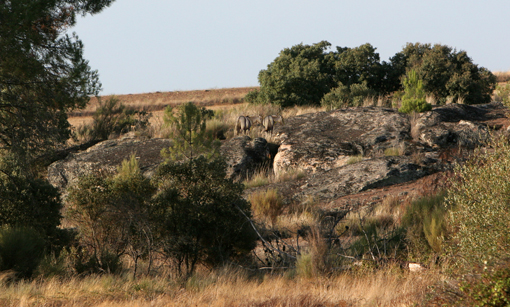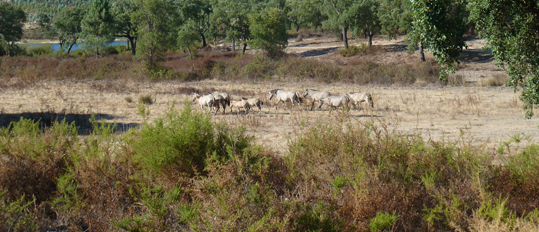DUN FACTOR COLOR AND WHITE MARKINGS

Herd of grulla and dun Sorraias in Portugal (Font‘Alva)
Photo Oelke
„I have seen a picture of a Sorraia that had a white marking. How do you explain that? I thought if they were really wild, primitive horses, they could not have white markings. Also, I have seen a picture of another one that looked to me like brown in color...“—Such questions and remarks are not uncommon. First of all, nobody has ever claimed that Sorraias were entirely pure anymore. One explanation for white markings in these horses is that they may reflect some outside (domestic) blood that has cropped out. The same can be said in regard to off colors (any color other than regular grulla or dun).
Probably 95 per cent or more of the Sorraias do not have any white marking. A Sorraia with a white marking is an exception, not a typical example.
If an author is using a horse with a sock as an illustration, or an off-colored one, like a black or a brown, that simply shows his or her ignorance.
There is another explanation, other than outside (domestic) blood: White markings occasionally occur in many, if not most, wild species, as well as albinism and melanism. For instance, there have been spotted deer, white buffalo, white elephants, black foxes, spotted birds, etc. Inbreeding is yet another explanation for white markings.
In regard to a preservation effort, the question is: If you want to preserve a species, would you select the odd-colored ones for that purpose? Or would you—as in the case of the Sorraia—rather try to preserve what is typical?
White markings usually occur as a by-product of domestication and inbreeding, the latter often being linked to domestication. The extreme inbreeding in today's Sorraias alone would explain the occurence of an occasional white marking. White markings occur in the Mongolian wild horse (Przewalski‘s horse) just as well.
Unfortunately, the people managing the Portuguese National Stud do not seem to have really appreciate their Sorraias for what they are, and have been treating them like so many domestic horses. They for a long time did not seem to mind white markings. They could easily have gotten rid of the few animals that possess some white, meaning to exclude them from the breeding process. The grandchildren of Ruy d'Andrade own most of today's Sorraia population and hardly ever have one with white, and they certainly discriminate against white should it crop out.

How well especially the grulla color works as camouflage is shown here—in a wider view that included more of the landscape, the two grulla Sorraias would be even harder to detect. These bolders are found over much of the land particularly in Portugal's eastern half

Even in an open spot like here, a whole family band of Sorraias blends in well with the landscape in the Vale de Zebro Refuge, difficult to detect from a distance as long as the horses don't move
Photos Oelke
Sorraias are typically grulla or dun of a lighter shade, without white, with a dark face resp. muzzle, bi-colored mane and tail, leg stripes in addition to the dorsal stripe, and sometimes stripes on the neck, over the back, and on the head.
What historical documents we have suggest that grulla (mouse-dun) was the original color of the wild equine (zebro) that the Sorraia is believed to trace back to.



